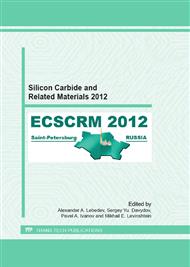p.409
p.413
p.417
p.421
p.425
p.431
p.435
p.439
p.443
Point Defects in SiC as a Promising Basis for Single-Defect, Single-Photon Spectroscopy with Room Temperature Controllable Quantum States
Abstract:
The unique quantum properties of the nitrogen–vacancy (NV) center in diamond have motivated efforts to find defects with similar properties in silicon carbide (SiC), which can extend the functionality of such systems not available to the diamond. As an example, results of experiments on electron paramagnetic resonance (EPR) and optically detected magnetic resonance (ODMR) are presented suggests that silicon vacancy (VSi) related point defects in SiC possess properties the similar to those of the NV center in diamond, which in turn make them a promising quantum system for single-defect and single-photon spectroscopy in the infrared region. Depending on the defect type, temperature, SiC polytype, and crystalline position, two opposite schemes have been observed for the optical alignment of the high-spin ground state spin sublevels population of the VSi-related defects upon irradiation with unpolorized light. Spin ensemble of VSi-related defects are shown to be prepared in a coherent superposition of the spin states even at room temperature. Zero-field (ZF) ODMR shows the possibility to manipulate of the ground state spin population by applying radiofrequency field. These altogether make VSi-related defects in SiC very favorable candidate for spintronics, quantum information processing, and magnetometry.
Info:
Periodical:
Pages:
425-430
Citation:
Online since:
January 2013
Price:
Сopyright:
© 2013 Trans Tech Publications Ltd. All Rights Reserved
Share:
Citation:


